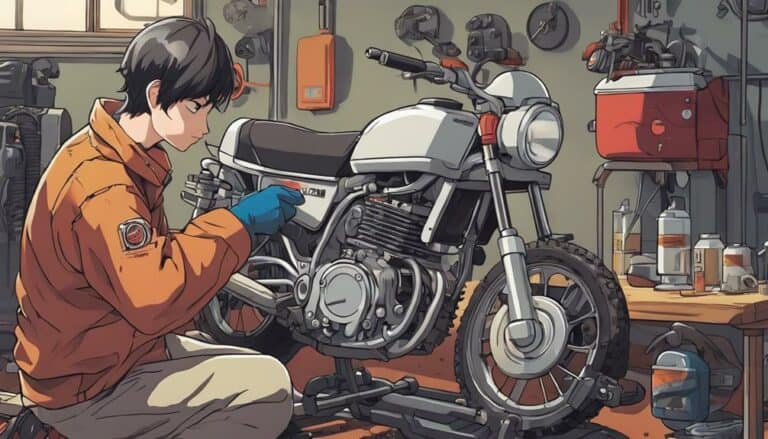So, you've decided it's time to tackle the carburetor adjustment on your Honda 100 dirt bike.
You might be wondering where to begin and how to make sure your bike is running at its best.
Understanding the intricacies of carburetor adjustment can make a significant difference in your bike's performance.
Stay tuned to uncover the essential steps and tips for adjusting your Honda 100 dirt bike carburetor like a pro.
Key Takeaways
- Locate carburetor adjustment screws for precise tuning.
- Use proper tools for accurate adjustments and maintenance.
- Adjust idle speed and air-fuel mixture for optimal performance.
- Test bike after adjustments to ensure peak performance.
Carburetor Adjustment Basics
When adjusting the carburetor on your Honda 100 dirt bike, understanding the Carburetor Adjustment Basics is essential for top engine performance.
The rule of thumb for starting is to locate the adjustment screws on the carburetor body. The idle speed adjustment screw should be turned using a screwdriver to set the idle speed of the engine. This guarantees the engine runs smoothly without stalling.
Additionally, adjusting the air-fuel mixture is important for best performance. By turning the mixture screw, you can achieve the correct balance, which affects how efficiently the engine burns fuel.
Proper adjustment of the throttle cable is also important to prevent stalling or over-revving. Fine-tune the carburetor adjustments by testing the bike's performance and making small adjustments as needed.
Following these basic steps will help you achieve peak engine performance on your Honda 100 dirt bike.
Tools Required for Adjustment
To properly adjust the Honda 100 dirt bike carburetor, make sure you have the necessary tools such as a screwdriver, wrench, and carburetor adjustment tool for precise adjustments. These tools are essential for performing carburetor maintenance and fine-tuning the air-fuel mixture and idle speed. When tuning techniques are employed, the correct tools aid in achieving best performance by allowing you to access and adjust various carburetor components accurately. Following the manufacturer's guidelines and specifications is important to make sure that the adjustments are made correctly.
Having the right tools not only simplifies the adjustment process but also contributes to the smooth operation and efficient fuel combustion of the Honda 100 dirt bike engine. Proper tool recommendations are vital for anyone looking to maintain their dirt bike's carburetor effectively. By using the appropriate tools and techniques, you can make sure that your Honda 100 dirt bike performs at its best and remains in top condition.
Locating the Carburetor on Your Honda 100
The carburetor on your Honda 100 dirt bike can typically be located on the side of the engine, near the air filter and intake manifold. To help you better understand the carburetor, here are some key details to assist in identification, common issues, and maintenance tips:
| Identifying Features | Common Issues | Maintenance Tips |
|---|---|---|
| Distinct shape | Clogging of jets | Regular cleaning |
| Fuel and air lines | Poor idling | Proper adjustment |
| Adjustment screws | Lean or rich mixture | Inspect for leaks |
When locating your carburetor, observe its unique shape and the connections of fuel and air lines. Common issues like clogging can lead to poor performance. Regular maintenance, such as cleaning and adjustments, is essential for the best dirt bike operation. Keep an eye out for signs of a lean or rich mixture and make sure no leaks are present. Understanding these features will aid in efficient carburetor adjustments for your Honda 100.
Step-by-Step Carburetor Adjustment Process
Upon locating the carburetor on your Honda 100 dirt bike, proceed with the step-by-step carburetor adjustment process to optimize its performance. Start by adjusting the idle speed screw using a screwdriver to guarantee smooth idling and prevent stalling.
Next, fine-tune the air-fuel mixture by adjusting the air screw for peak performance. Check the throttle cable for proper tension, guaranteeing smooth acceleration by adjusting if necessary. Remember to test the bike after adjustments to verify that the carburetor is correctly set for peak performance.
Troubleshooting tips include checking for air or fuel leaks that may affect performance. Common mistakes to avoid during adjustment are turning screws too tightly, which can damage the carburetor, and neglecting regular maintenance. It's essential to follow the maintenance schedule recommended by the manufacturer to keep the carburetor functioning at its peak.
Testing and Fine-Tuning the Carburetor
Fine-tune your Honda 100 dirt bike carburetor by carefully adjusting the air screw and idle speed screw for peak performance. To make sure your carburetor is functioning at its best, follow these steps:
- Perform a Throttle Test: Check for smooth acceleration and responsiveness by gradually increasing the throttle. Any hesitations or stutters indicate a need for adjustment.
- Use a Tachometer: Monitor the engine's RPM range with a tachometer to verify it's running at the correct levels for efficient performance.
- Adjust Air Screw and Idle Speed Screw: Fine-tune these screws to achieve the best idle performance and throttle response.
- Fine-Tune Needle Clip Position: Make sure the needle clip is in the correct position to maintain the proper fuel mixture at various throttle positions.
Conclusion
Now that you have adjusted the carburetor on your Honda 100 dirt bike, you can enjoy smoother engine performance and peak fuel efficiency.
Remember, a well-tuned carburetor is essential for the overall health of your bike. So, keep up with regular maintenance and adjustments to make certain your ride runs like a well-oiled machine.
As they say, a finely tuned carburetor is the heart of a dirt bike, so keep it in top condition for the best riding experience.

